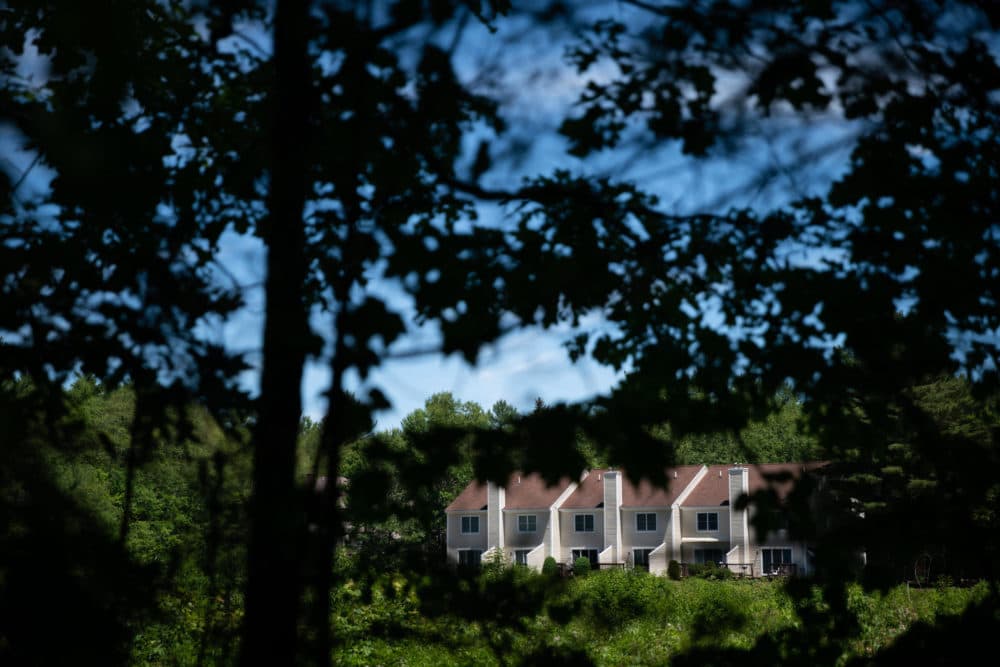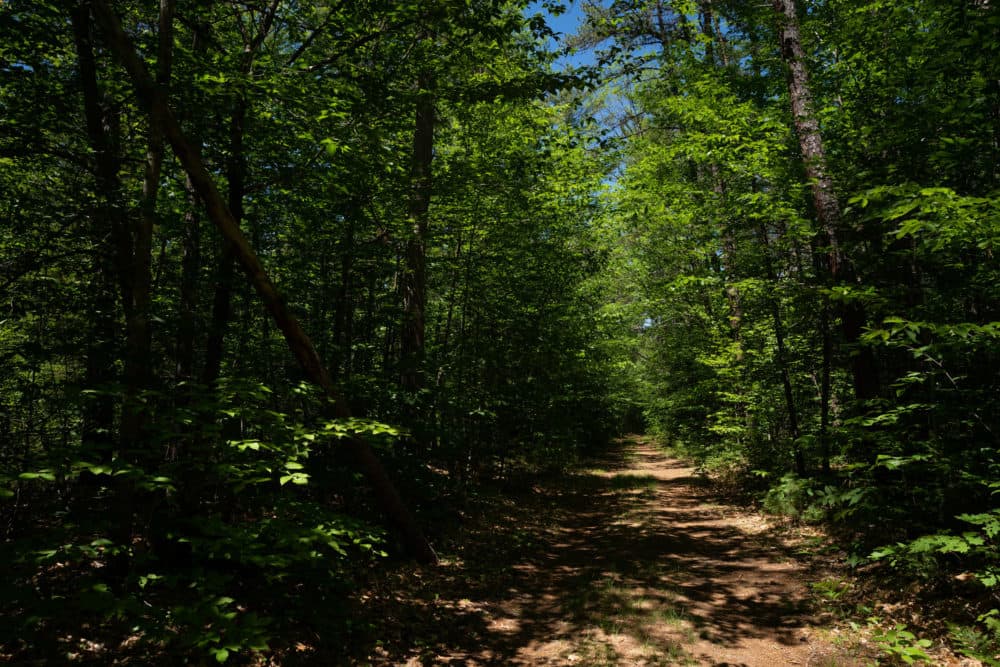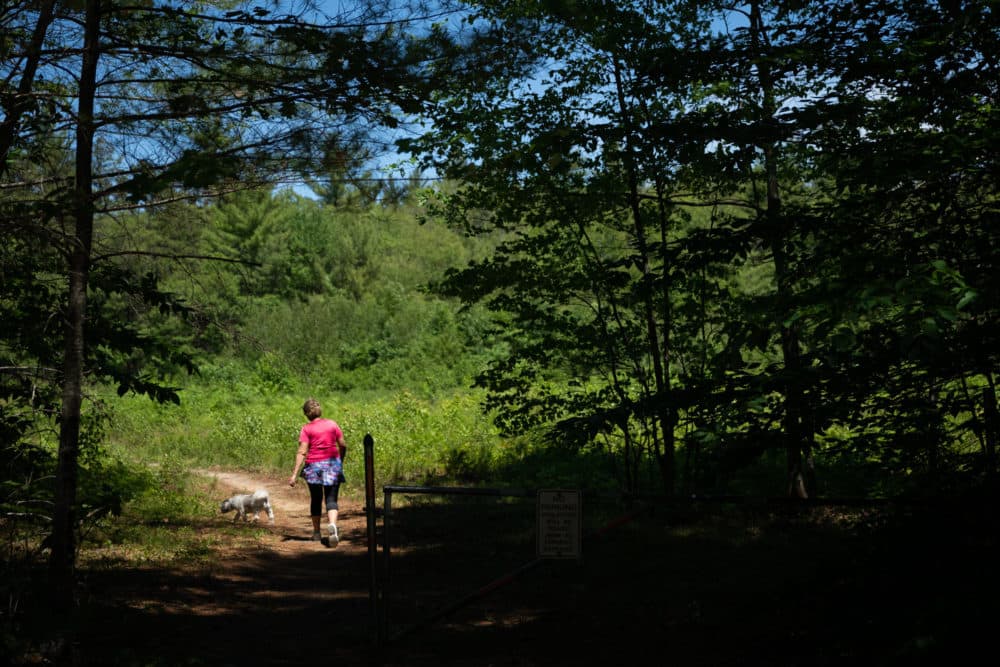Advertisement
White Mountain Forest Steps Up Wildfire Prevention Efforts In High-Risk New Hampshire Neighborhoods

The warming climate is raising the risk of wildfires across the entire U.S., even in states like New Hampshire. Now, forest managers in the White Mountains are stepping up their efforts to prevent major damage, and warning neighbors: It could happen here.
On the edge of the White Mountain National Forest in Conway, public lands with dense woods fill the backyards of houses.
District forest ranger Jim Innes lives around here. He’s one of the forest managers trying to warn residents of the White Mountains about forest fires.
When we visited last month – the hottest and driest June on record in New Hampshire – Innes dug down into the leaf litter just within the forest boundary, and all he saw was fire risk.
“It’s just all dry leaves. This stuff will catch in a minute – all it would take is a cigarette or something like that.” He kept digging. “It’s dry … like all the way down.”
Innes was crouched next to a strip of dirt that’s often used by local mountain bikers and dog walkers. It looks like a trail, but it’s actually a fire break, kept clear by the Forest Service with leaf blowers and chainsaws.

For a long time, creating these fire breaks and thinning out vegetation has been the bulk of the Forest Service's fire prevention strategy in this area. They maintain these gaps which would interrupt any fire that started near these homes, and make it easier to put out.
But lately, Jim Innes feels like he should do more. New Hampshire's been in a drought for over a year. And a lot more people have been in the woods here during the pandemic. Innes estimates forest managers put out hundreds of campfires last year.
"Bunches,” said habitat biologist Jessie Dubuque, who was with us in the woods. “Yeah, it was an incredible amount."
Innes and Dubuque have deployed to fight huge fires out west in recent years, so they know what the worst-case scenarios are like. Dubuque said she witnessed some of the most extreme fire behavior she’s ever experienced during a fire she worked on in Oregon last year.
“It was completely out of control and really kind of scary,” she said.
'I Just Want To Get Ahead Of It'
Climate change is playing a role in driving fire risk across the country. In New Hampshire, increased rain is still interrupted by long dry stretches, with hotter temperatures, shorter winters and less snow.
So when Jim Innes looks at the forest around Conway today, he sees a potential disaster waiting to happen.
"I just want to get ahead of it so I don’t have to be in that position to explain to these people, like, 'Oh, sorry you lost your house,'” he said. “It could happen. And I don’t want that, obviously, no one does."
Forest service researcher Adele Fenwick has been studying the history of these fires in the area, including on South Moat Mountain in Conway.
"There are a lot of subtle dangers that people out West are accustomed to and still may or may not do anything about,” Fenwick said. “But I think in the East fewer people are aware of the dangers around their house."
This summer, the Forest Service will conduct a controlled burn to clear out the dry fuels here. They'll do similar burns up and down the edge of the forest in the next few years in Albany, Jackson and Bartlett and repeat the process every five to seven years into the future.

For the National Forest, it's a new way of using fire as a tool. In the past, they've mostly burned to clear space for nesting birds or blueberry crops. Now they're thinking about community protection, for neighbors like Becky Bishop.
Bishop was walking her dog Rocky when she ran into the Forest Service workers, recognizable by their tan uniforms. The first thing she asked them was: "Are they going to do that burn?"
Bishop moved from a more developed part of Conway, a few years ago, to the condos at the edge of the forest. "I love it out here," she said. "It's beautiful, it's nice and quiet and the dog likes it … we have the best views."
She recently got a public notice about the burn project that will soon take place in her backyard. She's never worried about wildfires before, but she's glad it's happening.
"I just think it's a safety issue with everything being so dry and stuff,” she said. “I know these guys [the Forest Service] take good care of it and they manage the forest here really well, so it's never been a concern. But I think it's a great idea that they do this."
An analysis prepared for NHPR by Dover-based Athenium Analytics, which gauges weather risks for insurers and the U.S. government, puts the Conway burn site at a medium risk for a wildfire. That risk is elevated in the adjacent neighborhood, mainly due to its many structures surrounded by dense vegetation.
"We can see clear signals of droughts in the Athenium Analytics weather data record," the analysis says of the Conway area. "The current deficit in soil moisture conditions and increase in temperatures can lead to enhanced fire risk this summer."
A History Of Forest Fires
New Hampshire's North Country has had some big fires in recent years. The Dilly Cliff fire in Woodstock in 2017 took a month to put out, temporarily closing part of the Appalachian Trail. The year before that, a fire spread from a campground to a covered bridge in Albany, not far from the Conway prescribed burn site.
Every year, structure fires stem from brush burning and threaten multiple homes in wooded areas of the state. And drought can limit the availability of water to fight these fires.
Sporadic human-caused fires can also be bigger and longer-lasting than the kind that used to happen here every 10 or 15 years. Research like Adele Fenwick's shows more than a century of evidence of small fires from lightning strikes, or set by Indigenous people and, later, colonists.
Until the late 1800s, this pattern of fire helped clear out brush and limit worse damage from out-of-control blazes. Then came huge fires from logging and railroad construction. The government cracked down on intentional burning.
There were some catastrophic fires elsewhere in the region after that – including the blazes that covered large swaths of New Hampshire and Maine in 1947, reshaping Acadia National Park.
But Fenwick's research suggests that more natural burns in the 20th century would have kept these ecosystems more balanced, potentially mitigating accidental fires that did spring up. They would have controlled the vegetation that flames up more easily, and burned back the dry leaf litter that builds up on the forest floor.
Now, that litter keeps fires smoldering out of sight for days. This was a big problem in fighting the Albany Covered Bridge fire of 2016, according to forest ranger Jim Innes.
Fenwick is helping Innes's team with the Forest Service expand the ways it mimics those natural burns of the past in new parts of the White Mountains, hoping to protect fragile, fire-dependent species like the jack pines that grow on rocky outcrops and mountain ridges.
She hopes the Forest Service's outreach about prescribed fires will have the added benefit of reminding community members to take more care around their properties, by moving flammable materials like shrubbery, firewood and pine needles away from the house.
These land managers agree that larger fires, damaging life and property, could happen again in New Hampshire. They hope, with more prevention and awareness, that it won't.
This story is a production of the New England News Collaborative. It was originally published by New Hampshire Public Radio.